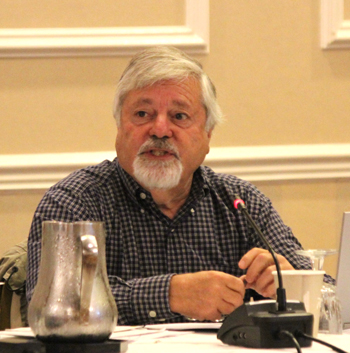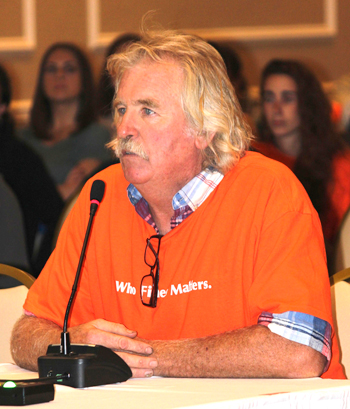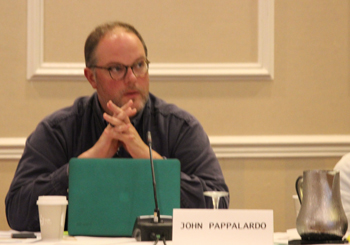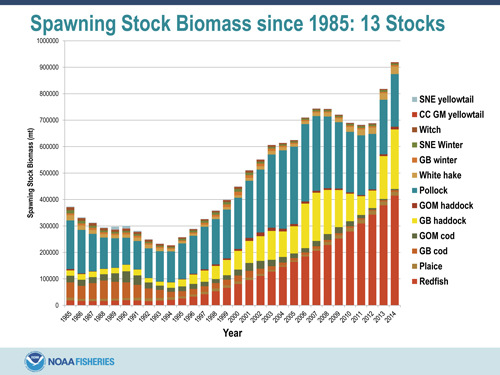Council Declares Amendment 18 Flawed Then Votes It In
continued from Homepage

NEFMC at-large member Michael Sissenwine. “In theory, someone with deep pockets could buy up Potential Sector Contribution and shelve it. It would not be fished. We’re creating a situation that could result in making it much more difficult to achieve OY [optimum yield], which is, in fact, our charge. So I’m concerned about this.” Fishermen’s Voice photo
“It feels like we’re making things up on the fly,” said NEFMC member John Pappalardo. “The document here doesn’t answer a lot of questions that have come up today. I’m still toying with the idea of making a motion to scuttle this whole thing and send it back for further development….There’s a sense that folks just want to get this over with, but I’m not sure that’s the best course of action right now.”
Ed Barrett, a commercial fisherman from Marshfield, Mass., said he predicted, during the development of Amendment 16, that sector management would never work.
“We’re here in Amendment 18, pretty far down the road in a process that’s included years of scoping and committee meetings, and we have an amendment that’s not going to fix a thing,” Barrett said. “Right now, all we’re arguing over is the minutiae of a bad business model. This has been a waste of taxpayer money. It has failed me as a business owner, it’s failed my family’s business, it’s failed my fishing community. We need to stop this amendment right here. We need to go forward with something that will fix the problems that are killing the industry right now.”
“Give us the names of the five or seven guys who are going to own this fishery,” said Sandwich, Mass., fisherman William Chaprales. “We’re going too fast. Slow down. Let’s shelve this.”
Chaprales referred to the report produced by consulting firm Compass Lexecon (CL), which was charged in 2013 by NEFMC to determine if excessive market share currently exists in the groundfishery and to recommend potential constraints that could prevent excessive shares in the future. CL concluded there was no evidence of excessive market share and recommended accumulation limits in the 15.5 to 25 percent range on stock-specific potential sector contributions, and said lesser controls could reduce efficiency unnecessarily. PSC is an individual fisherman’s historical share of landings of groundfish species
“Back when we had Compass Lexecon,” said Chaprales, “I got called and they asked me a bunch of questions, which were the wrong ones. I said, Why don’t you take a count of the effect of what’s going on here in the coastal communities of New England? Because I knew good fishermen—small-boat, owner-operated—that are all going to be going out of business. When you do a study and a guy says, ‘This is what’s wrong with you,’ there’s a real problem. You don’t go home and say, ‘I’ll take this guy’s word for it.’ You get a second or a third opinion. We didn’t do this with Compass Lexecon.”
Kyle Molton, policy director with the Penobscot East Resource Center in Stonington, said countless people are already impacted by the issues.
“This is really playing in the minutiae of a system that has failed owner-operator, small-scale fishermen,” said Molton. “I called sector members in preparation for this meeting, and the level of discontent, the level of depression—these guys have come with ideas to rebuild this fishery, to rebuilt their communities. This accomplishes none of that.”
Molton continued, “There’s nothing here that prevents a couple of environmental groups from buying up all the permits and shutting this fishery down. The people who would prefer to close this fishery down have deeper pockets than any of the fishermen here. Is that a wise way to manage this resource? I think not.”
Molly Bajgot, an employee with Red’s Best Fish Company, a fish aggregator that’s located on the Fish Pier in Boston and sources from more than 1,000 small boats in New England, said the business is modeled on the idea of sourcing from a diverse fishing fleet.
“I’ve seen how consolidation hurts natural resources and people,” Bajgot said. “Will there be thousands of fisher folk to source from if this trend continues? I’m afraid the answer will be no.”
Shannon Eldredge, a Chatham, Mass., fisherman and president of the Northwest Atlantic Marine Alliance in Gloucester, Mass., said Amendment 18 was supposed to help diversify the fleet, and help small-boat fishermen to maintain independence as owner-operators.
“But many members on this council are not working to ensure that protection,” Eldredge said. “If quota can be bought by only a few companies, then we’re looking at a Walmart situation on the ocean. All the mon-and-pop boats are bought by the big guys, leaving no access to future generations.”

Ed Barrett, commercial fisherman, Marshfield, Mass. “We’re here in Amendment 18, pretty far down the road in a process that’s included years of scoping and committee meetings, and we have an amendment that’s not going to fix a thing. Right now, all we’re arguing over is the minutiae of a bad business model.” Fishermen’s Voice photo
Eldredge said NEFMC has failed to listen to the innovative ideas fishermen have discussed. “Stop making decisions based on what you think is right and start listening to what the fishermen think are proactive steps toward a healthier ocean and a better-managed resource,” Eldredge said. “The work that happens around this council table has ramifications far beyond the New England groundfish fleet.” For example, she said, fishermen forced out of groundfish will put pressure on other fisheries. “So what happens next? Are you going to catch share dogfish?”
“I’m upset because I’ve seen a lot of people struggling with costs,” said Westerly, R.I., fisherman Jason Jarvis. “My son just did a trip where the observer made more money than the crew and captain. That’s tough to swallow.”
Tim Barrett, who runs the FV Odessa out of Plymouth, Mass., and is vice president of Sector 10, said Sector 10 earlier this year concluded that its 30 fishermen had enough quota for one boat to fish for four months.
“Sector 10 winds up being the canary in the coalmine because we have allocations that are very low, but it’s also an example of how this policy has failed,” Barrett said. “In this harbor here, we used to have seven, eight, nine boats that were continually fishing. Now there’s are no federally permitted boat leaving Plymouth. In the ‘80s, there were five tractor-trailer loads of fish coming off the pier every day. Most of the people are already bankrupt….When you have something like Amendment 18 come up, or ideas to prevent consolidation, and it takes four years to even get to this point, that system is broken.”
At a meeting earlier this year, NEFMC recommended their preferred alternatives for Amendment 18:
• Limit accumulation of PSC, in aggregate across all stocks, by individuals and entities to no more than 15.5 percent.
• Limit permits that may be held to no more than 5 percent.
• Create a sub-annual catch limit (ACL) that Handgear A (HA) permits could enroll in; remove the March 1-20 closure for common pool HA vessels; remove the standard fish tote requirement for HA vessels; allow sectors to annually request that HA vessels fishing in the sector be exempt from use of vessel monitoring systems (VMS).
• Maintain the status quo on data confidentiality, specifically the price of annual catch entitlements (ACE) transferred within a sector or leased between sectors.
• Do not establish an inshore/offshore boundary within the Gulf of Maine.
• Establish an area in which vessels could fish with a smaller mesh net than the standard mesh size, targeting redfish.
At the hearings, some fishermen expressed their concern that the 15.5 percent cap could leave the fishery in the hands of just seven fishermen. Others said accumulation is necessary to some extent in order for a business to be profitable.

John Pappalardo, NEFMC member and former Council chairman. “The document (Amendment 18) here doesn’t answer a lot of questions that have come up today. I’m still toying with the idea of making a motion to scuttle this whole thing and send it back for further development.” Fishermen’s Voice photo
NEFMC members argued for a cap on the cap, preventing entities from buying more than 15.5 percent of PSC and simply shelving the amount above 15.5 percent.
“In theory, someone with deep pockets could buy up PSC and shelve it,” said NEFMC at-large member Michael Sissenwine. “It would not be fished. We’re creating a situation that could resolve in making it much more difficult to achieve OY [optimum yield], which is, in fact, our charge. So I’m concerned about this. Also, the overwhelming comment was this isn’t ready, or doesn’t achieve the goals. Frankly, this sort of discussion we’re having now, where we can’t figure out what we’re trying to achieve, makes it hard not to agree with those comments.”
In the end, NEFMC voted on the following as their preferred alternatives:
• Limit the holdings of permits to no more than 5 percent.
• Limit PSC holdings to an average of 15.5 percent of all allocated stocks, and prohibit individual entities from purchasing more permits once they reach the 15.5 percent PSC aggregate cap.
Amendment 18 goes to the National Marine Fisheries Service for approval, and is due to be implemented May 1, 2016.

NOAA/NMFS stock biomass data shows recovery strong in three stocks.
Contradictions remain between what many fishermen report they are seeing in the water,
particularly in the cod stocks, and what this graph suggests. NOAA graphic
